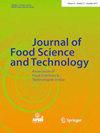酵母来源对雨树酒挥发性成分及感官特性的影响
IF 3.3
3区 农林科学
Q2 FOOD SCIENCE & TECHNOLOGY
引用次数: 0
摘要
背景:雨树是公园中常用的观赏植物。成熟的豆荚通常在结果季节散落在树的周围。由于它的香气和香甜的果肉,动物和儿童被吸引来吃豆荚。含糖果肉在食品工业尤其是葡萄酒生产中没有得到最佳利用。目的:以不同来源的酿酒酵母为原料,对沙曼果肉进行发酵,研究其对酒的挥发性成分和感官特性的影响。方法:以去籽豆荚(果肉)为原料,用从果肉(固有)中分离的酿酒酵母、啤酒酵母、面包酵母发酵,不进行发酵剂培养,制备Samnea saman酒。研究了其挥发性成分、气味活性值(OAVs)和感官特性。获得的三份数据使用SPSS软件版本21进行单向方差分析。采用均值和Fisher最小显著性差异(LSD)进行均值分离(p≤0.05)。结果:异戊醇(140.25 ~ 165.58μg/L)、1-丙醇(133.53 ~ 153.32μg/L)、甲醇(58.57 ~ 66.65μg/L)、乙酸乙酯(43.36 ~ 52.25μg/L)和己酸乙酯(20.54 ~ 32.59μg/L)是接受度最高的酒样中主要的同系物。气味oav分别为6517和482的己酸乙酯和乙酸异戊酯对葡萄酒样品的香气贡献很大。用天然酵母或啤酒酵母发酵的样品产生了更高浓度的挥发性化合物和气味活性值,与商业葡萄酒(对照)非常相似(8),与其他两种葡萄酒显著(p≤0.05)不同。结论:酵母的来源影响沙曼酒的挥发性成分和感官特性。由于固有酵母优于啤酒酵母,甚至优于面包酵母,因此它可以在工业上用作商业酵母的替代品。沙曼果浆可作为食品工业中糖的替代原料。本文章由计算机程序翻译,如有差异,请以英文原文为准。
Impact of Source of yeast on Volatile Composition and Sensory Properties of Samanea saman ( Rain tree) Wine
Background: Samanea saman (Rain tree) is commonly used in parks for ornamental. The ripe pods are usually littered around the tree site during fruiting season. Animals and children are attracted to it and eat the pods because of its aroma and sweet pulp. The sugary pulp is not optimally utilized in the food industry especially in wine production. Purpose: The aim was to ferment Samanea saman pulp must with different sources of Saccharomyces cerevisiae and investigate their impact on the volatile composition and sensory properties of the wine. Method: Samnea saman wine was processed from the de-seeded pods (pulp) fermented with Saccharomyces cerevisiae isolated from the pulp (inherent), brewer’s yeast, baker’s yeast and without starter culture. The volatile composition, odour activity values (OAVs) and sensory properties were investigated. Triplicate data obtained were subjected to OneWay ANOVA using SPSS software version 21.Mean values and Fisher’s Least Significant Difference (LSD) were determined for the separation of the means at (p≤0.05). Results: Isoamylalcohol (140.25-165.58μg/L), 1-propanol (133.53-153.32μg/L), methanol (58.57-66.65μg/L), ethylacetate (43.36-52.25μg/L) and ethylhexanoate (20.54-32.59μg/L) were the major congeners in the most accepted wine samples. Ethylhexanoate and isoamyl acetate with odour OAVs of 6517 and 482 respectively contributed highly to the aroma of the wine samples. The samples fermented with inherent yeast or brewer’s yeast produced higher concentrations of volatile compounds, odour activity values and were very much liked (8) as the commercial wine (control) and significantly (p≤0.05) different from the other two. Conclusion: The source of yeast influenced the volatile composition and sensory properties of Samanea saman wine. Since the inherent yeast compared favorably with brewer’s yeast and even better than baker’s yeast, it can be utilized industrially as alternative to commercial yeasts. The Samanea saman pulp can be used as alternative source of sugar in food industry.
求助全文
通过发布文献求助,成功后即可免费获取论文全文。
去求助
来源期刊
CiteScore
7.70
自引率
0.00%
发文量
274
审稿时长
11 months
期刊介绍:
The Journal of Food Science and Technology (JFST) is the official publication of the Association of Food Scientists and Technologists of India (AFSTI). This monthly publishes peer-reviewed research papers and reviews in all branches of science, technology, packaging and engineering of foods and food products. Special emphasis is given to fundamental and applied research findings that have potential for enhancing product quality, extend shelf life of fresh and processed food products and improve process efficiency. Critical reviews on new perspectives in food handling and processing, innovative and emerging technologies and trends and future research in food products and food industry byproducts are also welcome. The journal also publishes book reviews relevant to all aspects of food science, technology and engineering.

 求助内容:
求助内容: 应助结果提醒方式:
应助结果提醒方式:


